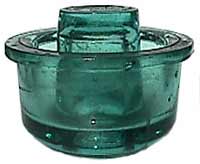
 |
Battery Insulators,
|
From the first time that a cell or battery was used to supply electricity ... a way was needed to prevent or reduce the leakage of electric current. This leakage occurred when over the surface of the cell or battery (and the support that it was placed on) became coated with a fine deposit of acid-laden moisture and dust.
It was found that electric leakage was reduced if each cell or battery (a series of cells) was isolated from the support on which it sat.
Wood framing was used, but it was discovered that, over time, the wood would absorb the acid-laden moisture and created a direct path for electrical leakage, and eventually the acid moisture would cause the wood to rot.
Battery Insulators were used with DC electric systems as low as 1-2 volts and up to 600 volts and greater.
Lower DC voltage was used for a short time with telegraphs, alarms, and
railroad signals. Higher voltage was used for lighting, motors, pumps, etc.
Originally, plain glass battery insulators were placed between wooden stringers
and the battery tank. This proved to be insufficient ... so, glass insulators
were added between the wood stringers and the floor. This combination became
known as "Double Insulation."
.
.
For more information, read the complete article on
Battery Insulators, Oil Insulators and Chloride Accumulators (580 KB PDF).
![]() To
see some additional photographs, see the
Battery Rest Insulators Album in
the PicturePoster Gallery.
To
see some additional photographs, see the
Battery Rest Insulators Album in
the PicturePoster Gallery.
![]() Return to the Insulator Go-with's
page
Return to the Insulator Go-with's
page
If you have questions or comments, please feel free to contact Charles Irons at
Written Thursday, August 1, 1996; Last updated Thursday, December 15, 2005